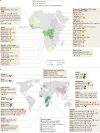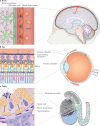Viral genomics in Ebola virus research
- PMID: 32367066
- PMCID: PMC7223634
- DOI: 10.1038/s41579-020-0354-7
Viral genomics in Ebola virus research
Abstract
Filoviruses such as Ebola virus continue to pose a substantial health risk to humans. Advances in the sequencing and functional characterization of both pathogen and host genomes have provided a wealth of knowledge to clinicians, epidemiologists and public health responders during outbreaks of high-consequence viral disease. Here, we describe how genomics has been historically used to investigate Ebola virus disease outbreaks and how new technologies allow for rapid, large-scale data generation at the point of care. We highlight how genomics extends beyond consensus-level sequencing of the virus to include intra-host viral transcriptomics and the characterization of host responses in acute and persistently infected patients. Similar genomics techniques can also be applied to the characterization of non-human primate animal models and to known natural reservoirs of filoviruses, and metagenomic sequencing can be the key to the discovery of novel filoviruses. Finally, we outline the importance of reverse genetics systems that can swiftly characterize filoviruses as soon as their genome sequences are available.
Conflict of interest statement
All authors declare no competing interests.
Figures






Similar articles
-
Ebola virus ecology: a continuing mystery.Trends Microbiol. 2004 Oct;12(10):433-7. doi: 10.1016/j.tim.2004.08.009. Trends Microbiol. 2004. PMID: 15381189 Review. No abstract available.
-
Marburg and Ebola--arming ourselves against the deadly filoviruses.N Engl J Med. 2005 Jun 23;352(25):2571-3. doi: 10.1056/NEJMp058109. N Engl J Med. 2005. PMID: 15972860 No abstract available.
-
Emerging and reemerging of filoviruses.Arch Virol Suppl. 1996;11:77-100. doi: 10.1007/978-3-7091-7482-1_9. Arch Virol Suppl. 1996. PMID: 8800808 Review.
-
Tissue and cellular tropism, pathology and pathogenesis of Ebola and Marburg viruses.J Pathol. 2015 Jan;235(2):153-74. doi: 10.1002/path.4456. J Pathol. 2015. PMID: 25297522 Review.
-
Sequencing ebola and marburg viruses genomes using microarrays.J Med Virol. 2016 Aug;88(8):1303-8. doi: 10.1002/jmv.24487. Epub 2016 Feb 8. J Med Virol. 2016. PMID: 26822839
Cited by
-
Genomics and Bioinformatics in One Health: Transdisciplinary Approaches for Health Promotion and Disease Prevention.Int J Environ Res Public Health. 2024 Oct 9;21(10):1337. doi: 10.3390/ijerph21101337. Int J Environ Res Public Health. 2024. PMID: 39457310 Free PMC article.
-
Attempted Transmission of Marburg Virus by Bat-Associated Fleas Thaumapsylla breviceps breviceps (Ischnopsyllidae: Thaumapsyllinae) to the Egyptian Rousette Bat (Rousettus aegyptiacus).Viruses. 2024 Jul 25;16(8):1197. doi: 10.3390/v16081197. Viruses. 2024. PMID: 39205171 Free PMC article.
-
A Bivalent Bacterium-like Particles-Based Vaccine Induced Potent Immune Responses against the Sudan Virus and Ebola Virus in Mice.Transbound Emerg Dis. 2023 Apr 24;2023:9248581. doi: 10.1155/2023/9248581. eCollection 2023. Transbound Emerg Dis. 2023. PMID: 40303775 Free PMC article.
-
Natural Products with Potential to Treat RNA Virus Pathogens Including SARS-CoV-2.J Nat Prod. 2021 Jan 22;84(1):161-182. doi: 10.1021/acs.jnatprod.0c00968. Epub 2020 Dec 22. J Nat Prod. 2021. PMID: 33352046 Free PMC article. Review.
-
Metagenomic Pathogen Sequencing in Resource-Scarce Settings: Lessons Learned and the Road Ahead.Front Epidemiol. 2022;2:926695. doi: 10.3389/fepid.2022.926695. Epub 2022 Aug 15. Front Epidemiol. 2022. PMID: 36247976 Free PMC article.
References
-
- National Center for Biotechnology Information. GenBankhttps://www.ncbi.nlm.nih.gov/genbank/ (2019).
-
- Kuhn, J. H., Amarasinghe, G. & Perry, D. L. in Fields Virology: Emerging Viruses Ch. 12 (eds Peter Howley, M. Knipe, David M. & Whelan, Sean P. J.) (Wolters Kluwer, 2020).
-
- World Health Organization. Situation report. Ebola Virus Disease. https://apps.who.int/iris/bitstream/handle/10665/208883/ebolasitrep_10Ju... (2016).
-
- World Health Organization. Ebola in the Democratic Republic of Congo. Health Emergency Update. https://www.who.int/emergencies/diseases/ebola/drc-2019 (2020).
Publication types
MeSH terms
Grants and funding
LinkOut - more resources
Full Text Sources
Medical

